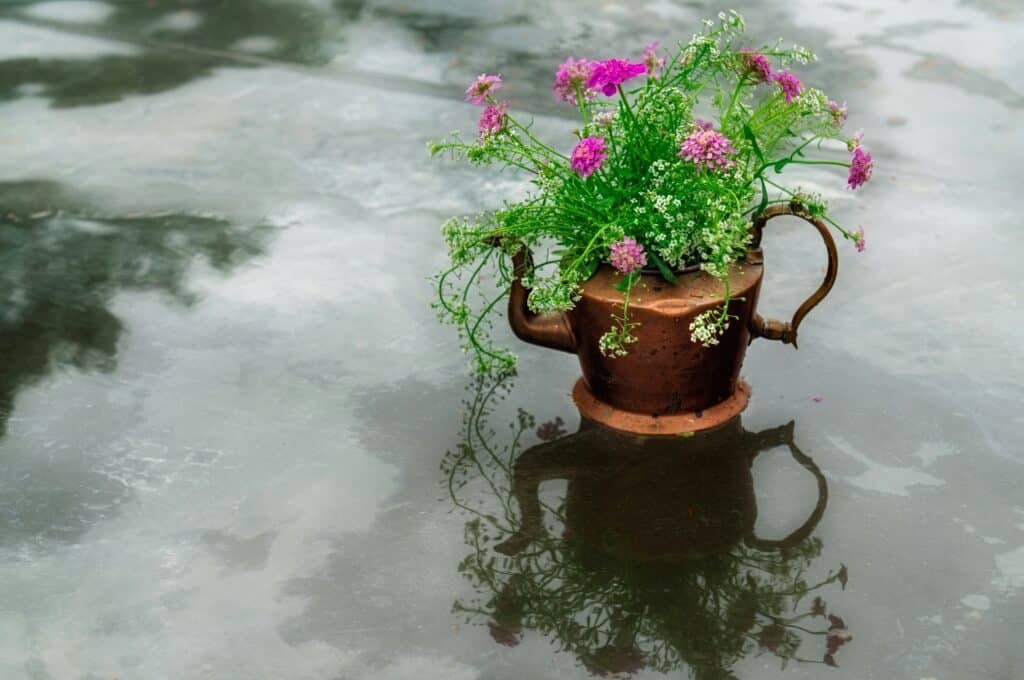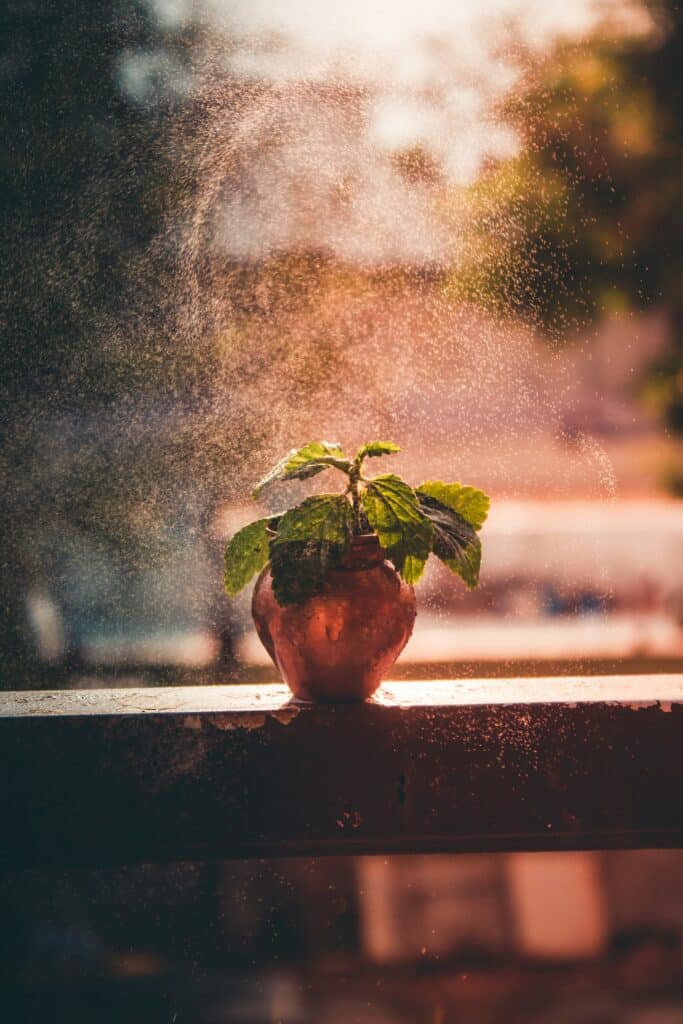This game-changer in the gardening sphere allows plants to hydrate themselves, bringing an end to the era of constant, labor-intensive watering. The magic of these planters lies in their ability to efficiently store water and gradually supply it to the plants as per their requirements. So, prepare to bid farewell to the daily hassle of watering your indoor and outdoor plants.
With a self-watering planter, your plants gain autonomy, and you gain peace of mind. Whether you’re at work, traveling, or simply juggling a busy schedule, these planters ensure that your plants continue to receive the hydration they need to thrive. They are especially ideal for small-space gardening, balcony setups, or urban apartments, where space and time are often limited.
Moreover, DIY self-watering planters open up creative opportunities for personalization. You can design them using upcycled materials like buckets, totes, or even plastic bottles, contributing to sustainability while saving money. They are perfect for growing everything from herbs and leafy greens to vibrant flowers and ornamental plants.
In essence, self-watering planters make gardening more accessible, reliable, and enjoyable for everyone—regardless of experience level. 🌱💧🌿

An exploration of this DIY self-watering planters concept forms the core of this content. It’s designed to guide you on a journey through the nuts and bolts of these ingenious devices, from their functionality to their construction. Imagine the satisfaction of building your own planter and then watching your plants flourish with minimal intervention from your end.
In the forthcoming sections, we’ll delve into the myriad benefits of these self-watering planters and how they contribute to healthier plant growth. Expect to be enlightened about the science behind their self-watering mechanism and how this promotes optimal plant health. We will also touch upon how they can contribute to water conservation – a highly relevant topic in our present-day environment.
Finally, armed with detailed step-by-step instructions, you’ll be empowered to create your very own DIY self-watering planter. The goal is to make plant care a breeze, freeing up your time and energy for other pursuits, all while enjoying the sight of thriving plants. Prepare for a refreshing change in your gardening routine! 🌱💧🌿
Expanding on the Environmental Impact of Self-Watering Planters
One of the lesser-discussed but significant benefits of DIY self-watering planters is their positive environmental impact. These systems use water far more efficiently than traditional watering methods, helping reduce water waste significantly. In a world where water conservation is becoming increasingly critical, adopting self-watering planters allows gardeners to participate in a sustainable practice that lessens strain on natural resources. Additionally, when you upcycle materials such as plastic containers, PVC pipes, or even fabric strips, you’re reducing landfill waste. These planters encourage a zero-waste philosophy while fostering environmental stewardship—making them a perfect fit for eco-conscious households and green living advocates.
Ideal Plants for Self-Watering Planters
While almost any plant can be grown in a self-watering planter, certain species are particularly well-suited to this growing method. Leafy greens such as lettuce, kale, spinach, and herbs like basil and parsley thrive in consistent moisture environments provided by self-watering systems. Succulents and cacti, which require drier conditions, may not benefit as much unless carefully monitored. Flowering annuals such as petunias and marigolds also do well in self-watering containers, as do cherry tomatoes and peppers. By selecting the right plants, you maximize the efficiency of your planter while ensuring lush, vibrant growth with minimal intervention.
Troubleshooting Common Issues
Despite their many advantages, self-watering planters can occasionally present challenges. One common issue is root rot, which may occur if the wicking system is too efficient and the soil becomes oversaturated. To prevent this, use a light potting mix that promotes good drainage and ensure the overflow hole is working properly. Another potential problem is clogged wicks, especially if organic matter builds up in the reservoir. Regular maintenance and inspection of the wicking material can help avoid this issue. Lastly, algae buildup in clear or semi-transparent reservoirs can be controlled by painting the outside or wrapping them in fabric.
Customization and Aesthetic Ideas
DIY self-watering planters don’t have to be plain. With a little imagination, they can be customized to suit any decor. Paint the exterior to match your patio or balcony, wrap them in burlap for a rustic look, or stencil plant names onto the surface for added charm. You can even repurpose unique containers—like old drawers, crates, or wooden boxes—and line them with a water reservoir system. These personalized touches turn your planters into statement pieces, allowing them to double as functional gardening tools and stylish home decor.
The Science Behind Self-Watering Planters

As a mechanical phenomenon, self-watering planters rely on the principle of capillary action. This fundamental principle, which states that liquid can flow upwards against gravity in narrow spaces or porous material, is used to create a constant water supply for the plants.
To better comprehend, imagine a sponge soaking up a spill. The water is drawn upwards through the tiny spaces between the sponge’s cells. Similarly, the plant’s roots take up water from the planter’s reservoir through the same capillary action.
Additionally, these planters incorporate a mechanism known as hydroponics, a method of growing plants without soil by using mineral nutrient solutions in a water solvent. This combination of capillary action and hydroponics optimizes plant hydration, promoting healthy growth and reducing the likelihood of overwatering or underwatering.
Components of Self-Watering Planters
Self-watering planters, also known as sub-irrigated planters (SIPs), are smart gardening systems designed to deliver water directly to plant roots with minimal effort. These systems reduce water waste, prevent overwatering, and promote healthier, more consistent plant growth. They consist of several fundamental components:
- Planting Container:
This is the top section where your plants and potting mix reside. The container needs to have a few holes at the bottom—not for standard drainage, but to allow the wicking mechanism to function effectively. Some DIY versions use a standard flowerpot placed inside a larger container. - Water Reservoir:
Located below the planting container, the water reservoir stores the water that will be drawn upward through capillary action. Depending on the design, this could be as simple as a large bucket, a plastic tote, or even an upcycled bin. - Wicking Chamber:
The key to the self-watering system, this part connects the soil with the water supply. It can be a column of soil reaching down into the water reservoir or a wicking material like cotton fabric or natural fiber rope that extends from the water up into the soil. The idea is to maintain a moist environment that steadily hydrates the root zone without saturating it. - Overflow Hole:
This safety feature ensures the planter doesn’t become overfilled. If too much rain or water is added, the excess will drain through this hole, preventing root rot or waterlogged conditions.
Choosing the Right Materials
Selecting suitable materials is essential for building a durable, efficient self-watering planter. Here are the most commonly recommended options:
Potting Mix:
Use a light, soilless potting mix with components like coconut coir, perlite, and peat moss. This ensures good aeration and water retention, which are critical in self-watering systems
Plastic Containers:
Lightweight, durable, and easily modifiable, plastic bins, buckets, or storage totes are ideal for both the planting and reservoir components. Ensure the plastic is labeled food-safe if you plan to grow vegetables or herbs.
Wicking Material:
Natural cotton ropes, strips of old cotton t-shirts, or even sphagnum moss can serve as effective wicks. These materials draw water upward naturally without deteriorating quickly. Avoid synthetic materials like polyester or nylon, which can break down or become ineffective over time.
Additional considerations include ensuring all materials are non-toxic and safe for prolonged exposure to water and soil. For added longevity, consider UV-resistant plastics that won’t degrade in sunlight. If aesthetics matter, choose containers in neutral or earth tones to complement your space, or decorate them for a personalized touch.
Assembling Your DIY Self-Watering Planter
Building your own self-watering planter is not only a cost-effective way to grow plants, but also an excellent solution for busy gardeners or those living in hot climates. Here’s a detailed guide to help you construct one:
Step 1: Prepare Your Containers
You’ll need two plastic containers—ideally, one should nest comfortably inside the other. The bottom container will act as the water reservoir, while the top one will hold the soil and plants. Choose food-grade plastic if you intend to grow edibles.
Step 2: Create the Wicking Chamber
Cut a section of PVC pipe or use a small plastic cup with holes drilled into it to act as the wicking chamber. This chamber will draw water from the reservoir into the soil using capillary action. Fill the chamber with a soil or perlite mixture to facilitate wicking.
Step 3: Drill Drainage and Overflow Holes
Drill drainage holes in the bottom of the planting container. Then, drill an overflow hole in the reservoir container, about 1 inch below the bottom of the planting container. This prevents water from flooding the soil and roots.
Step 4: Insert a Fill Tube
Use a length of PVC pipe or a wide straw to create a fill tube. Place it vertically into the reservoir to make watering easier. This tube should protrude above the soil level so you can easily add water directly to the reservoir.
Step 5: Assemble the Planter
Place the wicking chamber in the reservoir, align the planting container on top, and ensure the wicking chamber connects through one of the holes. Insert the fill tube, and fill the planting container with potting mix.
Step 6: Plant and Water
Add your seeds or transplants, then water from the top once to establish moisture. Afterwards, use the fill tube to maintain water levels.
This setup ensures consistent hydration, reduces watering frequency, and promotes healthier root systems. Happy planting! 🌱
Maintenance Tips for Self-Watering Planters
After your DIY self-watering planter is assembled and your plant is in place, it’s important to maintain the system properly. This includes regular checking of the water level in the reservoir and refilling it as needed.
Keep in mind that while self-watering planters simplify watering, they do not eliminate the need for other essential plant care, such as fertilizing and providing adequate sunlight.
By understanding the principles and components behind self-watering planters and by choosing the right materials, you can successfully assemble your DIY planter. With proper maintenance, your plants will thrive with less effort on your part, leaving you more time to enjoy the beauty of your green space.
Conclusion
In conclusion, the Grow with Ease: DIY Self-Watering Planters have revolutionized the way we care for our plants, offering a practical and efficient solution for effortless plant care. By eliminating the need for constant watering, these self-watering planters not only save us time but also ensure our plants get the optimal amount of water they need to thrive. This ingenious product is perfect for busy individuals, beginners in gardening, or those who are simply forgetful when it comes to watering their plants.
The DIY aspect of these planters also allows for creativity and personalization, making it a fun and engaging activity that you can enjoy alone or with your family. With these self-watering planters, maintaining a beautiful, healthy garden has never been easier. It’s a genuine game-changer that brings a new level of convenience to gardening.
Beyond convenience, these planters also support sustainable living. They conserve water, reduce waste, and can be built using upcycled materials, making them ideal for eco-conscious gardeners. Whether you’re growing herbs in your kitchen, flowers on your balcony, or vegetables on your patio, the versatility of self-watering systems ensures consistent plant health with minimal input.
So, say goodbye to constant watering and welcome a new era of effortless plant care with DIY Self-Watering Planters. They are a testament that in gardening—as in life—the best solutions are often the simplest. With these planters, you grow not just your plants, but also your confidence, sustainability practices, and passion for gardening. 🌱🌻💧



